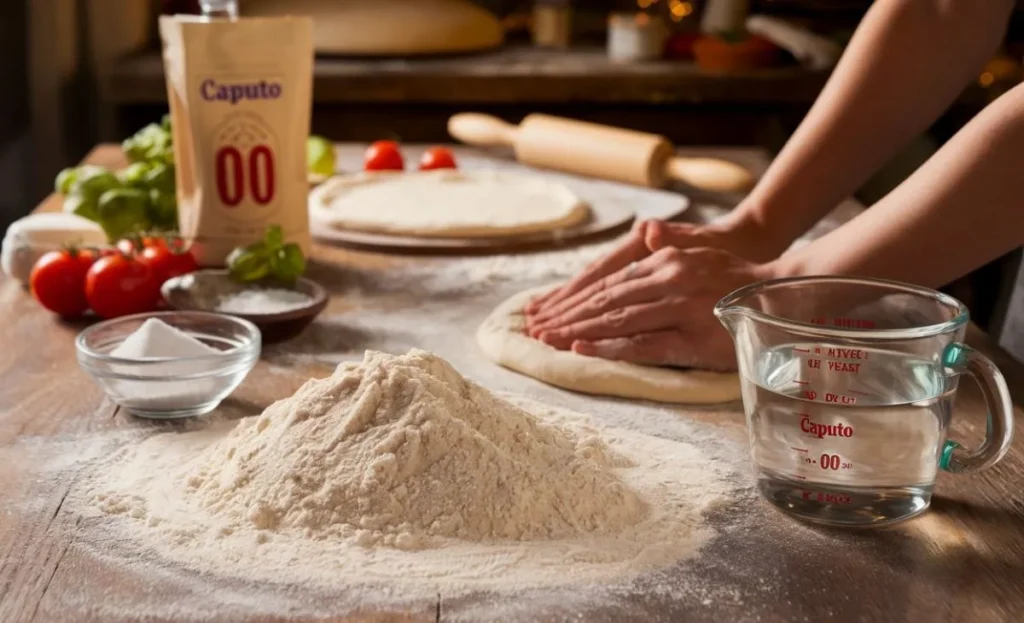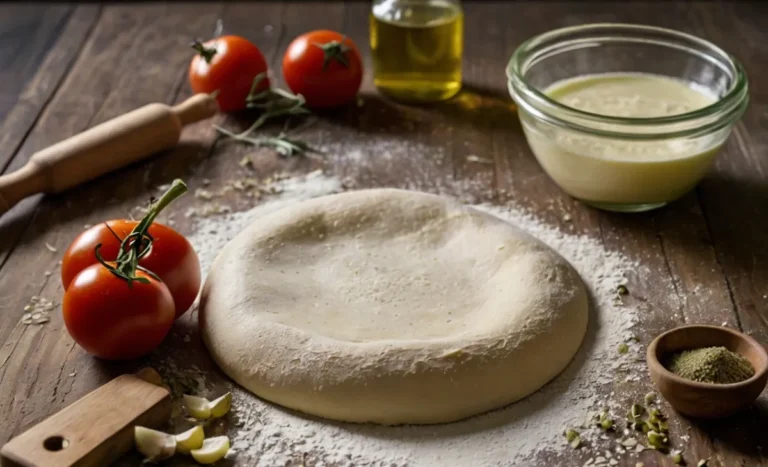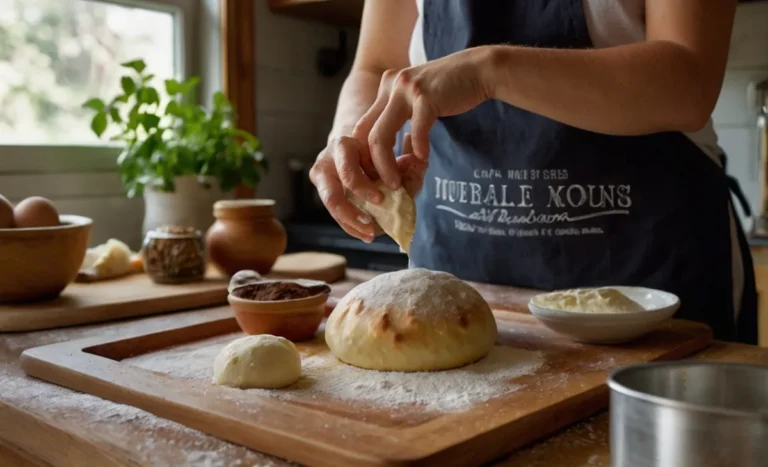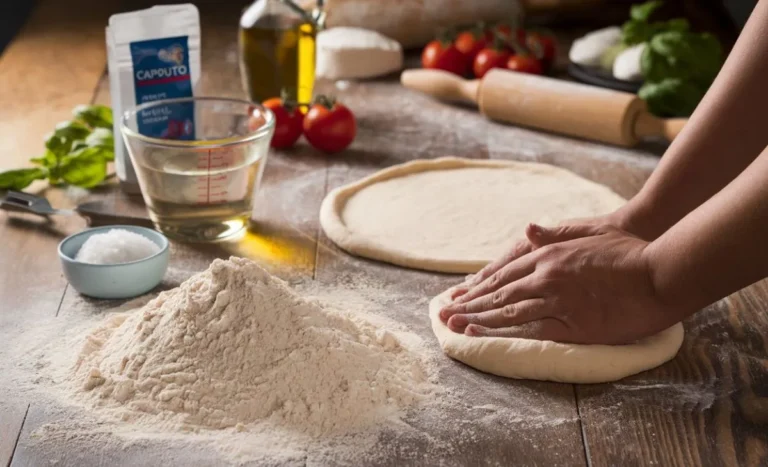How to Master the Caputo Pizza Dough Recipe for Restaurant-Quality Results
Introduction to Caputo Pizza Dough: The Secret to Authentic Flavor
If you’re aiming for restaurant-quality results at home, the Caputo pizza dough recipe is your secret weapon. Known for its fine texture and high gluten content, Caputo 00 flour elevates your pizza to a new level of authenticity. This type of flour is milled specifically for pizza, making it essential for creating that classic Neapolitan-style crust. By mastering this dough recipe, you’ll unlock the rich flavors and perfect chew that define a great pizza.
One of the keys to Caputo dough is its simplicity. With just a few high-quality ingredients—flour, water, yeast, and salt—you can create a delicious base for your favorite toppings. Each component plays a vital role in developing flavor and structure. The combination of these ingredients, paired with proper technique, leads to a crust that is both crispy and chewy. As a result, your homemade pizza will rival that of your favorite pizzeria.
Another important aspect is the fermentation process. Allowing the dough to rise slowly enhances its flavor and texture. Caputo dough benefits from longer fermentation times, which develop complex flavors and a light, airy texture. By letting the dough rest, you’ll achieve the optimal balance between tenderness and chewiness. This patience will reward you with a crust that has a delightful aroma and rich taste.
In conclusion, mastering the Caputo pizza dough recipe opens the door to endless culinary possibilities. Whether you prefer classic Margherita or creative gourmet pizzas, this dough sets the foundation for success. By focusing on high-quality ingredients, proper techniques, and adequate fermentation, you’ll create an authentic pizza experience that impresses family and friends alike.
Essential Ingredients for Perfect Caputo Pizza Dough
Creating the perfect pizza starts with understanding the essential ingredients in the Caputo pizza dough recipe. Each component plays a crucial role in achieving that restaurant-quality flavor and texture. By selecting high-quality ingredients, you set the foundation for a delicious pizza crust that will impress everyone at your table. Let’s explore these key ingredients and their significance in the dough-making process.
First and foremost, Caputo 00 flour is the star of this recipe. This finely milled flour is specifically designed for pizza-making, providing the ideal gluten structure. The high protein content in Caputo flour allows for excellent elasticity, resulting in a chewy and airy crust. This flour also absorbs water well, contributing to the dough’s hydration and texture. Using Caputo 00 flour ensures your pizza will have an authentic Neapolitan-style crust that is both crispy and tender.
Next, water is a vital ingredient in the Caputo pizza dough recipe. The quality and temperature of the water can significantly affect the dough’s outcome. Using room temperature or slightly warm water helps activate the yeast, promoting proper fermentation. Additionally, the hydration level of the dough influences its overall texture. A well-hydrated dough leads to a lighter crust, so balancing water with flour is essential for achieving the perfect consistency.
Lastly, don’t overlook the importance of salt and yeast. Salt enhances the dough’s flavor and strengthens the gluten structure, while yeast is responsible for fermentation and rising. Using active dry yeast or fresh yeast can yield excellent results, but be mindful of the yeast’s freshness for optimal activity. When combined with the other ingredients, these two elements work together to create a flavorful and well-risen dough. By carefully selecting and balancing these essential ingredients, you’ll be well on your way to mastering the Caputo pizza dough recipe and creating restaurant-quality pizzas at home.
Step-by-Step Process: Making Your Dough from Scratch
Creating pizza dough from scratch is an essential skill for any home cook seeking to achieve restaurant-quality results. The Caputo pizza dough recipe is a fantastic way to begin this journey. With just a few simple ingredients and some patience, you can craft a delicious, authentic pizza crust that will impress your family and friends. Follow this step-by-step process to make your dough from scratch.

Ingredients:
- 500g Caputo 00 flour
- 325ml warm water (about 100°F or 38°C)
- 10g sea salt
- 3g active dry yeast
- 1 tablespoon olive oil (optional)
Step 1: Activate the Yeast
Start by activating your yeast. In a small bowl, combine the warm water and active dry yeast. Let it sit for about 5-10 minutes until it becomes frothy. This step ensures that the yeast is alive and ready to help your dough rise.
Step 2: Combine the Ingredients
In a large mixing bowl, add the Caputo 00 flour and sea salt. Mix them together well. Once combined, create a well in the center of the flour mixture. Pour in the activated yeast mixture and olive oil (if using). Using a fork or your fingers, gradually mix the flour into the liquid until a shaggy dough begins to form.
Step 3: Knead the Dough
Transfer the dough onto a lightly floured surface. Knead it for about 8-10 minutes until it becomes smooth and elastic. If the dough is sticky, add a little more flour, but be cautious not to add too much. Kneading develops the gluten, giving your pizza crust its desired texture.
Step 4: First Rise
Shape the kneaded dough into a ball and place it in a lightly greased bowl. Cover the bowl with a damp cloth or plastic wrap to prevent it from drying out. Allow the dough to rise at room temperature for 1-2 hours, or until it has doubled in size.
Step 5: Shape and Rest
Once the dough has risen, gently punch it down to release the air. Divide it into smaller portions, typically around 250g for individual pizzas. Shape each portion into a ball and place them on a floured surface. Cover the dough balls with a damp cloth and let them rest for an additional 30 minutes.
By following this Caputo pizza dough recipe, you’ll have a beautifully risen dough ready for your favorite toppings. Enjoy the satisfaction of making your dough from scratch, and prepare to impress your guests with your culinary skills! ️
The Importance of Kneading: Techniques for Ideal Texture
Kneading is a crucial step in the Caputo pizza dough recipe that significantly impacts the texture of your crust. This process develops gluten, which gives the dough its structure and chewiness. When you knead the dough properly, it transforms from a sticky mixture into a smooth and elastic ball. As a result, the final pizza crust will be airy, crispy, and full of flavor. Understanding the importance of kneading ensures you achieve the desired quality in your homemade pizza.
To knead effectively, start by placing your dough on a clean, lightly floured surface. Use the palms of your hands to push the dough away from you, then fold it back toward yourself. Rotate the dough a quarter turn and repeat this motion. This technique helps distribute the ingredients evenly while building strength in the dough. Aim to knead for about 8 to 10 minutes, which allows the gluten to develop fully. As you knead, you should notice the dough becoming smoother and more elastic.
It’s important to monitor the dough’s texture during kneading. If it feels sticky, add a little more flour, but be careful not to overdo it. Excess flour can lead to a tough crust. Conversely, if the dough feels dry, sprinkle a few drops of water and continue kneading. Remember, the goal is to achieve a soft and pliable dough that springs back when gently pressed. This ideal texture will create the perfect base for your pizza, allowing it to rise beautifully during baking.
Finally, don’t underestimate the benefits of resting your dough after kneading. Allowing the dough to rest for at least 30 minutes gives the gluten time to relax. This makes the dough easier to shape and stretch when you’re ready to form your pizza. By mastering the kneading technique and understanding its importance, you can confidently tackle the Caputo pizza dough recipe and enjoy restaurant-quality results right in your kitchen.
Fermentation and Resting: Unlocking Flavor and Texture
Fermentation and resting are essential processes in the Caputo pizza dough recipe that unlock the dough’s full potential. These stages enhance the flavor and texture of your pizza crust, transforming it into a truly gourmet experience. During fermentation, the yeast ferments the sugars in the dough, producing carbon dioxide and alcohol. This fermentation process contributes to the dough’s complex flavors and airy structure, giving your pizza that restaurant-quality taste.
To achieve the best results, allow your dough to ferment for at least one to two hours at room temperature. This initial rise is crucial as it enables the yeast to activate fully. After the dough has doubled in size, gently punch it down to release excess gas. This step also redistributes the yeast throughout the dough, ensuring a more even flavor. You can also opt for cold fermentation by placing the dough in the refrigerator for an extended period, often 24 to 72 hours. Cold fermentation allows for a more pronounced flavor development and creates a better texture.
Resting the dough after fermentation is equally important. After dividing and shaping the dough into balls, let them rest for about 30 minutes. This resting period allows the gluten to relax, making the dough easier to stretch and shape. If you skip this step, you may find the dough resistant and difficult to work with, resulting in an uneven pizza crust. When the dough is properly rested, it will be more pliable, allowing for better manipulation without tearing.
Ultimately, the combination of fermentation and resting elevates the Caputo pizza dough recipe from ordinary to extraordinary. By giving your dough ample time to ferment and rest, you create a crust that is light, flavorful, and perfectly textured. This attention to detail is what sets restaurant-quality pizzas apart from homemade versions, allowing you to impress your guests with every slice.
Baking Techniques for a Crispy, Golden Crust
Baking is the final step in achieving a crispy, golden crust with the Caputo pizza dough recipe. This stage is crucial for transforming your raw dough into a delicious pizza that rivals those found in the best pizzerias. Using the right baking techniques can make all the difference in texture and flavor. With proper preparation and a few tips, you can create a pizza crust that is both flavorful and visually appealing.
To start, preheat your oven to its highest setting, typically around 475°F to 500°F (245°C to 260°C). A hot oven is essential for achieving that desired crispy crust. If you have a pizza stone, place it in the oven while it preheats. This ensures the stone absorbs heat, providing a perfect surface for baking. When you transfer the pizza onto a hot stone, the intense heat will create a beautifully crisp bottom in a short amount of time.
Another technique to enhance your crust is using a baking sheet or pizza peel to slide your pizza onto the stone. Make sure to sprinkle flour or cornmeal on the peel to prevent sticking. After assembling your pizza with your favorite toppings, carefully slide it onto the hot stone. Baking for about 8 to 10 minutes should yield a crust that is golden brown and delicious. Keep an eye on the pizza during the final minutes to ensure it does not overcook.
Lastly, consider broiling your pizza for the last minute of baking. This technique helps achieve a perfectly charred and crispy top. Simply switch your oven to the broil setting and watch closely to avoid burning. Once your pizza is done, remove it from the oven and let it cool for a minute before slicing. This resting time allows the crust to firm up slightly, making it easier to cut. By mastering these baking techniques with the Caputo pizza dough recipe, you’ll be well on your way to creating restaurant-quality pizzas right at home.
Common Mistakes to Avoid: Tips for Consistent Success
When mastering the Caputo pizza dough recipe, avoiding common mistakes is crucial for achieving restaurant-quality results. Many home cooks overlook small details that can significantly impact the final product. By understanding these pitfalls, you can ensure consistent success every time you make pizza dough. Awareness of these common errors will help elevate your pizza-making skills.
One frequent mistake is not measuring ingredients accurately. Using too much flour can lead to a dense, dry dough. Conversely, insufficient flour can result in a sticky mess that is hard to work with. Always use a kitchen scale for precision, especially when measuring flour and water. Additionally, ensure that your yeast is fresh. Expired yeast can fail to activate, causing your dough not to rise properly. These steps will provide a solid foundation for your dough.
Another mistake involves neglecting fermentation and resting times. Rushing through these processes can lead to bland flavors and poor texture. Allow your dough enough time to rise and develop flavors. For the best results, aim for at least one to two hours of fermentation at room temperature. If time permits, consider cold fermentation in the refrigerator for up to 72 hours. This longer fermentation period enhances the overall taste of your crust.
Finally, don’t underestimate the importance of proper baking techniques. Failing to preheat your oven sufficiently can lead to an undercooked crust. Always ensure your oven reaches the highest temperature possible before baking. Using a pizza stone can significantly improve your crust’s crispiness by providing direct heat. By avoiding these common mistakes, you can confidently tackle the Caputo pizza dough recipe and enjoy delicious, consistent results every time.
Caputo Pizza Dough Recipe: The Ultimate Guide for Perfect Homemade Pizza







